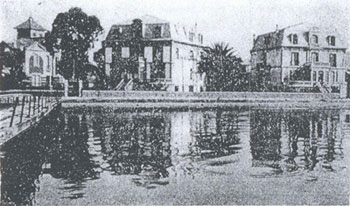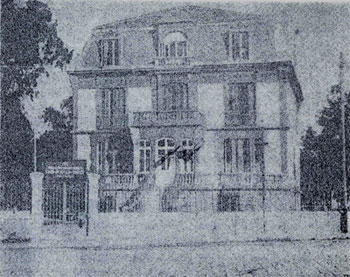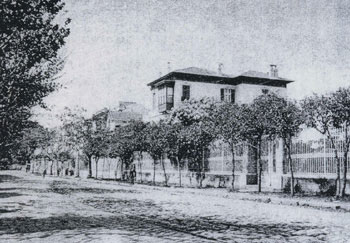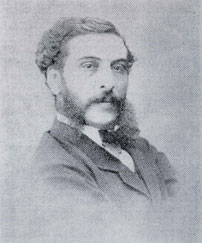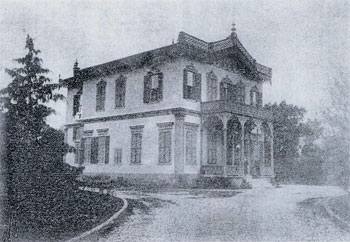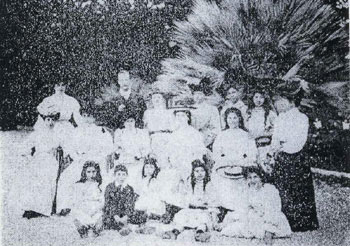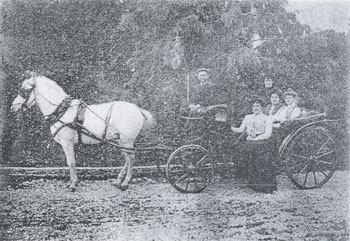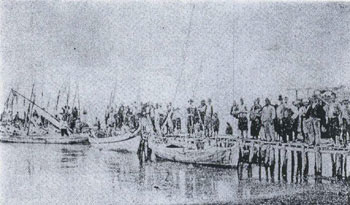Cordelio (Karşıyaka)
Some notes from the book Cordelio of Niko Kararas:
According to Kararas, the name Cordelio does not come from Richard Coeur de Lion (King Richard the Lionheart of England) as the 3rd Crusade of Richard did not pass this way. Cordelio’s, origin should be the Byzantine “Cordoleon” the Monastery, the Palace of the Cordoleon which was located here in the XIIIth Century.
During the early Ottoman Period, the Karaosmanoğlu clan where the local overlords for about a hundred years.
The railway line of the Smyrna – Kasaba (today’s Turgutlu) Railway Company passed and stopped at Cordelio from 1865. Then at the end of 1874, the Joly, Victora, Courmouli & Co Shipping Company put two steamers with English flags the “Cordelio” and “Göztepe” operating between Smyrna and Cordelio. Later in 1880 Popovitch and Sadik Bey put two more steamers on this route. Cordelio then progressed very quickly, the main street was the called the “Çarsı” lined with cafés and various shops, owned mainly by the local Greeks.
On the Seafront, “Quai”, just opposite of the actual Debarquadere (Maritime Station) was the Club1 with its veranda looking to the sea, with a cinema theater, buffet and billards. The upper floor was used as a hotel and in the ground floor was the Bireria (Beer Café) of Klonidi. The main building is still standing today – Öğretmenler Evi.
Beautiful villas graced the seafront, belonging to Greeks, Armenians, French, English, and Italians. Most of them had their own bathing facilities for swimming. These houses belonged to the French Belhomme, Charnaud, Löchner, Leventiadi, Bari, Toscani, Werry, Bondoz Ağa, Baliazoglu, and Iplixian. There were twin identical properties known as the houses of Kotzia (previous owner Pierre Aliotti). Other names were Tarladji, Nicolaidi, Antoniadi, Kokola, Kosta, Murat, Sotiri, Karakasi, Andrikidi, Vandoru, Granier, Eppstein, D’Andria, Galati, Milhousen, and others.
There were various streets starting at the seafront and heading in to the interior. The one from the Antoniadi House was the Boulevard Kokinakia, at the end of which were living the Devries and Fidao families. Heading from the Skala (Pier) of Belhomme was the Charnaud Street where the Satirical Poet Karakasi used to live. Close to the Charnaud Street was the Malcotsis Street which led us to the famous Gülistan, the romantic and exotic villa of the Poet Mihalaki Argiropoulo (1862 – 1949).
The population of Cordelio in 1888 was about 5,000, and around 1920 15,000.
Alaybey was to the north-east of Cordelio and was divided in to two quarters, upper and lower Alabey. Between Alaybey and Cordelio up to and over the railway line, was the big estate of about 90 dönüm of the Omiros (Homer) Family. Behind the great wall there were two beautiful villas, one with 15 rooms and the other with 8. There were stables, horses, carriages and all kinds of trees. This estate belonged to the rich Karolos F. Omiros (1837-1908)2. Karolos brought from Italy specialist gardeners and he had 2,000 trees and various flowers such as magnolia, where the beautiful Omiros daughters with their friends promenaded and looked like nereids with their white dresses.
Churches: There were three Greek Orthodox churches, St Anna3, St John Prodromu (Baptist), and Aghia Marina of Alaybey in which there was the tomb of the Omirou Family. St Anna was the metropolitan church. In 1891 this was a modest church but in 1898 a new and beautiful church was built by the architects Emanuel (Manolaki) Petrocochino4 and Nicolau Maganioti. St John was the church with its own cemetery situated to the western end of Cordelio. The Catholics in 1882 had a little church by the name of St Helena, a donation of Helen de Cramer. Later on with the initiative and donation of land by count Nicola Aliotti and the contribution by other Catholics, the new church of St Helena was built in 1904 with an imperial permission, and still functions today. There was also a little Catholic Church in the Alaybey area.
Schools: Kararas writes that towards 1922, there were as Greek schools, one for boys, one for girls and two pre-elementary schools, all of them belonging to the community. There were also 5 private Greek schools and that many children also went to the various schools in Izmir. There was a Turkish high school between Alaybey and Soğukkuyu and there were two Catholic Schools, Dames de Sion for girls and one of the Freres for boys.
Kararas in association with the researcher Livio Missir, mentions various old Catholic families of Cordelio such as the Aliottis, owners of considerable land around the area of St Helena Church. Other family names mentioned are the Van der Zee, Löchner, Charnaud, De Jongh, the family of Leopold Misir (1852-1928), Milovich, Valleri, Prossen, Mainetti, Guiffray, Corsi, Toscani, Apak, Calichiopoulo5 (mentioned as of Venetian origin), Balladur, Vassel, Issaverdens, Caraman. Finally, Armao, headed by the banker Adolphe Armao, who had a beautiful villa on the seafront called “Quisisana”.
At the end of his book, Kararas makes a long list of the old inhabitants of Cordelio, mainly Greek. I will mention a few, such as the Kotzias (for which unfortunately I have not found any detailed information), the Chiot origin Petrocochino and Omiros (Homer), the Veinoglu (relative to Omiros / Baltazzi), Galatis (probably of Chios origin), Warren, Cecil, Zafiris, Zares, Iplixian, Kolaros, Maganiotis, Malkotsis, Marinopoulos, Nicolaidi, Pittakis, Barker, Barff, Sariyan, Simeonidi, Foscolos etc.
For my own memories, I can remember that in the late 50s and early 60s, I often went to Karşıyaka6 with my cinephile friends to the cinemas of Melek and Sümer (on the seafront) and then proceeding to the Çarsı street to taste the famous lokma of Sami Patisserie. Later on we formed a group of Levantines, many of Karşıyaka and there were two young Karşıyaka girls, the two Deas. One Dea Palamari and the other Dea Filinesi (her parents had a very nice house with a big garden where we had garden parties). I remember families such as Penetti, Pariente, Petrini. Eric Löchner of Karşıyaka and Jim Giraud from Izmir, the senior stars of tennis. Eric always wore long white trousers – and despite my relatively young age at the time, they would invite me to play tennis with them. I had a good drive and did not make drop shots or lops which I think they disliked. There were many other Levantine families besides the ones already mentioned. As far as I remember, there were the Noccas, Maraccini, Dabour, Petrizza, Icard, Casagrande, Filipucci, Fragiacomo, Pipino, Edizel, Romano, Braggiotti, Massa, Mulino, Arcas, Faruggia and Zacharie, Tonna, Borg (the last three were inter-related) the majority of whom later transferred their residence to Izmir, Alsancak.
They were also many well-known Turkish families that had settled in Karşıyaka such as the Evliyazade, Leblebicioğlu, Meseretçi, Yaşar, Akkum, Aksoy, İşçimenler, Postacıoğlu, Sanver, Birsel, Noyan, Boztepe. My first wife Sonay Terzioğlu was from Karşıyaka. Her brother Somer, a famous sportsman in the quite reputed Karşıyaka Sports Club and many others who now live in the new developed Karşıyaka, in the direction of the former Scala tu Papa (Priest’s Pier), now Bostanlı and further on Mavişehir villas and apartments.
My good friend the writer Yaşar Aksoy in his book “Karşıyaka” (Izmir 1988) mentions the Turkish writers and poets native of Karşıyaka. Salah Birsel, Attila İlhan, Samim Kocagöz, Tarık Dursun and Şükran Kurdakuç.
Karşıyaka has also the historic importance that Atatürk stayed there in 1922 and his mother Zübeyde Hanım lived and died in Karşıyaka and her tomb at Osman Paşa Mosque is frequently visited and revered.
In Soğukkuyu there is a Moslem as well as a Catholic cemetery.
Alex Baltazzi, 2007
Click here for more views of old Cordelio
Click here for an abridged family tree of the Omeros family, showing connections with some of the Levantine families of Smyrna, kindly submitted by Mr George Vassiadis, 2007.
Click here for Mr Baltazzi’s companion article on the heritage of Boudja.
Click here for Mr Baltazzi’s companion article on the heritage of Paradiso / Şirinyer.
Click here for Mr Baltazzi’s companion article on the heritage of Seydiköy.
Click here for Mr Baltazzi’s companion article on the heritage of Bournabat / Bornova.
Click here for Mr Baltazzi’s companion article on the heritage of Bayraklı / Turan and region.

Some notes from the book Cordelio of Niko Kararas:
According to Kararas, the name Cordelio does not come from Richard Coeur de Lion (King Richard the Lionheart of England) as the 3rd Crusade of Richard did not pass this way. Cordelio’s, origin should be the Byzantine “Cordoleon” the Monastery, the Palace of the Cordoleon which was located here in the XIIIth Century.
During the early Ottoman Period, the Karaosmanoğlu clan where the local overlords for about a hundred years.
The railway line of the Smyrna – Kasaba (today’s Turgutlu) Railway Company passed and stopped at Cordelio from 1865. Then at the end of 1874, the Joly, Victora, Courmouli & Co Shipping Company put two steamers with English flags the “Cordelio” and “Göztepe” operating between Smyrna and Cordelio. Later in 1880 Popovitch and Sadik Bey put two more steamers on this route. Cordelio then progressed very quickly, the main street was the called the “Çarsı” lined with cafés and various shops, owned mainly by the local Greeks.
On the Seafront, “Quai”, just opposite of the actual Debarquadere (Maritime Station) was the Club1 with its veranda looking to the sea, with a cinema theater, buffet and billards. The upper floor was used as a hotel and in the ground floor was the Bireria (Beer Café) of Klonidi. The main building is still standing today – Öğretmenler Evi.
Beautiful villas graced the seafront, belonging to Greeks, Armenians, French, English, and Italians. Most of them had their own bathing facilities for swimming. These houses belonged to the French Belhomme, Charnaud, Löchner, Leventiadi, Bari, Toscani, Werry, Bondoz Ağa, Baliazoglu, and Iplixian. There were twin identical properties known as the houses of Kotzia (previous owner Pierre Aliotti). Other names were Tarladji, Nicolaidi, Antoniadi, Kokola, Kosta, Murat, Sotiri, Karakasi, Andrikidi, Vandoru, Granier, Eppstein, D’Andria, Galati, Milhousen, and others.
There were various streets starting at the seafront and heading in to the interior. The one from the Antoniadi House was the Boulevard Kokinakia, at the end of which were living the Devries and Fidao families. Heading from the Skala (Pier) of Belhomme was the Charnaud Street where the Satirical Poet Karakasi used to live. Close to the Charnaud Street was the Malcotsis Street which led us to the famous Gülistan, the romantic and exotic villa of the Poet Mihalaki Argiropoulo (1862 – 1949).
The population of Cordelio in 1888 was about 5,000, and around 1920 15,000.
Alaybey was to the north-east of Cordelio and was divided in to two quarters, upper and lower Alabey. Between Alaybey and Cordelio up to and over the railway line, was the big estate of about 90 dönüm of the Omiros (Homer) Family. Behind the great wall there were two beautiful villas, one with 15 rooms and the other with 8. There were stables, horses, carriages and all kinds of trees. This estate belonged to the rich Karolos F. Omiros (1837-1908)2. Karolos brought from Italy specialist gardeners and he had 2,000 trees and various flowers such as magnolia, where the beautiful Omiros daughters with their friends promenaded and looked like nereids with their white dresses.
Churches: There were three Greek Orthodox churches, St Anna3, St John Prodromu (Baptist), and Aghia Marina of Alaybey in which there was the tomb of the Omirou Family. St Anna was the metropolitan church. In 1891 this was a modest church but in 1898 a new and beautiful church was built by the architects Emanuel (Manolaki) Petrocochino4 and Nicolau Maganioti. St John was the church with its own cemetery situated to the western end of Cordelio. The Catholics in 1882 had a little church by the name of St Helena, a donation of Helen de Cramer. Later on with the initiative and donation of land by count Nicola Aliotti and the contribution by other Catholics, the new church of St Helena was built in 1904 with an imperial permission, and still functions today. There was also a little Catholic Church in the Alaybey area.
Schools: Kararas writes that towards 1922, there were as Greek schools, one for boys, one for girls and two pre-elementary schools, all of them belonging to the community. There were also 5 private Greek schools and that many children also went to the various schools in Izmir. There was a Turkish high school between Alaybey and Soğukkuyu and there were two Catholic Schools, Dames de Sion for girls and one of the Freres for boys.
Kararas in association with the researcher Livio Missir, mentions various old Catholic families of Cordelio such as the Aliottis, owners of considerable land around the area of St Helena Church. Other family names mentioned are the Van der Zee, Löchner, Charnaud, De Jongh, the family of Leopold Misir (1852-1928), Milovich, Valleri, Prossen, Mainetti, Guiffray, Corsi, Toscani, Apak, Calichiopoulo5 (mentioned as of Venetian origin), Balladur, Vassel, Issaverdens, Caraman. Finally, Armao, headed by the banker Adolphe Armao, who had a beautiful villa on the seafront called “Quisisana”.
At the end of his book, Kararas makes a long list of the old inhabitants of Cordelio, mainly Greek. I will mention a few, such as the Kotzias (for which unfortunately I have not found any detailed information), the Chiot origin Petrocochino and Omiros (Homer), the Veinoglu (relative to Omiros / Baltazzi), Galatis (probably of Chios origin), Warren, Cecil, Zafiris, Zares, Iplixian, Kolaros, Maganiotis, Malkotsis, Marinopoulos, Nicolaidi, Pittakis, Barker, Barff, Sariyan, Simeonidi, Foscolos etc.
For my own memories, I can remember that in the late 50s and early 60s, I often went to Karşıyaka6 with my cinephile friends to the cinemas of Melek and Sümer (on the seafront) and then proceeding to the Çarsı street to taste the famous lokma of Sami Patisserie. Later on we formed a group of Levantines, many of Karşıyaka and there were two young Karşıyaka girls, the two Deas. One Dea Palamari and the other Dea Filinesi (her parents had a very nice house with a big garden where we had garden parties). I remember families such as Penetti, Pariente, Petrini. Eric Löchner of Karşıyaka and Jim Giraud from Izmir, the senior stars of tennis. Eric always wore long white trousers – and despite my relatively young age at the time, they would invite me to play tennis with them. I had a good drive and did not make drop shots or lops which I think they disliked. There were many other Levantine families besides the ones already mentioned. As far as I remember, there were the Noccas, Maraccini, Dabour, Petrizza, Icard, Casagrande, Filipucci, Fragiacomo, Pipino, Edizel, Romano, Braggiotti, Massa, Mulino, Arcas, Faruggia and Zacharie, Tonna, Borg (the last three were inter-related) the majority of whom later transferred their residence to Izmir, Alsancak.
They were also many well-known Turkish families that had settled in Karşıyaka such as the Evliyazade, Leblebicioğlu, Meseretçi, Yaşar, Akkum, Aksoy, İşçimenler, Postacıoğlu, Sanver, Birsel, Noyan, Boztepe. My first wife Sonay Terzioğlu was from Karşıyaka. Her brother Somer, a famous sportsman in the quite reputed Karşıyaka Sports Club and many others who now live in the new developed Karşıyaka, in the direction of the former Scala tu Papa (Priest’s Pier), now Bostanlı and further on Mavişehir villas and apartments.
My good friend the writer Yaşar Aksoy in his book “Karşıyaka” (Izmir 1988) mentions the Turkish writers and poets native of Karşıyaka. Salah Birsel, Attila İlhan, Samim Kocagöz, Tarık Dursun and Şükran Kurdakuç.
Karşıyaka has also the historic importance that Atatürk stayed there in 1922 and his mother Zübeyde Hanım lived and died in Karşıyaka and her tomb at Osman Paşa Mosque is frequently visited and revered.
In Soğukkuyu there is a Moslem as well as a Catholic cemetery.
Alex Baltazzi, 2007
1 The Club was called Petrocochino as many pictures showed it. I do not know the reason. Petrocochino’s ownership, management (?) but probably the architect of this beautiful building was Emmanuel Petrocochino. There is in Izmir the street named 1482 close to the Italian School which used to be also called Petrocochino and probably the family lived there and was built by a Petrocochino (significant is the red brick of the buildings here also used in the Chian properties). The Petrocochinos had about 17 properties in Chios (Ref: Hioni Revue, No:165, November 2005, Chios). 
2 Omiros was a family originating from Chios and that had settled in Izmir long ago. They are mentioned in my writing “the Chians”. Karolos Omiros was married with Christina Baltazzi (1844-1899) daughter of my great-great grand father Emanuele Baltazzi (1790?-1855) and Catherine Petrocochino (1820-1883), sister of the archaeologist Demostene Baltazzi, my great grand father. They had 6 children, 3 sons, Fotiou, Emanuel and Paul and 3 daughters, Maria (Musuru), Liolias (Veinoglu) and Anna (Apostolidi). The contract of marriage between Christina Baltazzi and Karolo Omirou was solemnised at the Austrian Consulate of Izmir on 26 April 1862 and Christina brought as “dowry” 13,000 English Pounds.
3 My friend, the writer Yaşar Aksoy in his book “Karşıyaka” mentions that the Ankara İlkokulu [primary school] was founded in the place where the St Anna Orthodox Church was located and the same building was used for some time as a classroom. The Cumhuriyet İlkokulu, founded in 1924 was on the land formerly occupied by the Armenian Church.
4 Emanuel (Manoli) Petrocochino (Izmir 1856 – Athens 1930) from the great Chiot family, relative of the Baltazzi’s. Furthermore to be one of the most reputed architects, he was active in social life and had a great interest on urban matters recognized by all administrations. We see him elected in the list of the Izmir province Belediye Heyeti [Municipal Committee] of 5/7/1909 with 400 votes. And when it was decided to split the mayorships for Izmir (3) Karşıyaka and Buca, he was elected (1909) in the list of the commission to deal with this question. (Ref. Tanzimattan Cumhuriyete İzmir’de Belediye [Municipalities of Izmir from Tanzimat to the Republic] (1868-1945), Erkan Serçe/ Dokuz Eylül Yayınları, 1998.
5 Calichiopoulo is also mentioned by Sturdza in the Grandes Familles de Grece, de Constantinople et d’Albanie as a noble family of the Venetian Crete. I knew a Calichiopoulo in Izmir, a doctor and his son Yani, an architect married to a Valleri – but both were Greek Orthodox.
6 Alex Baltazzi, Antiche Sale Cinematografiche e il Cinema ad Izmir (Izmir’de Sinema ve Eski Sinemalar) [Cinema in Izmir and old film theatres], La Voce, Gennaio (Jan.) 2002.
7 According to contributor George Galdies: there were in Karşıyaka the Martins, who were probably originally Armenian, but then took on British nationality. A branch of the Martins went to India and later to Singapore where they flourished. Even literally as I believe a Miss Martin introduced the orchids which are now Singapore’s symbol.
8 More from the Yaşar Aksoy ‘Karşıyaka’ book:
The author conducted an interview in 1984 with Ada Fragiacomo who was 84 years old then and lived in Karşıyaka with his son Aldo Fragiacamo. Her father was the dentist Bernard Granier. The other four Granier brothers were also dentists amongst them Jean Baptiste who always wore a fez. According Ada they had a Köşk on the Aya Anna street (where Etibank now stands) and in front they had their jetty with a bathing cabin (on Ankara ilk okul sokağı). She remembered the first ferries Gülbahçe and Foscolo and she would travel free as her father was the official dentist of the Company.
In these times everybody was very elegant, the ladies in white and the men with nice hats.
In 1910 at the Venus Cinema (afterwards it would be called Melek) there were the first silent movies. Opposite it at the sea front there was the Venus Cafe and furthermore 3 more. The last one (now Yapı ve Kredi Bankası) was the Haralambos Cafe and Beer House. In the Halk Eğitim Merkezi. (My note: probably ex Petrocochino Club now Öğretmenler Lokali opposite the pier) was a Cinema on the ground floor and a skating area where I used to go stated Ada. On the upper floor balls were given. The Carnaval was very well enjoyed with dances etc. To dance with me they had to write their name on my carnet. The piano was played by Rozzati.
Sundays we would go to eat lokmas at the Bostanlı Gazinos.
She added that she studied at the Cordelio Notre Dame de Sion where later on would be the Karşıyaka Orta Okulu. In the same school were studying the sister of Adnan Menderes [future prime-minister] and the daughters of Mihri Evliyazade.
Our shopping needs were met by street vendors who were passing in front of the houses with their donkeys.
Ada added that she married Giovanni Fragiacomo in Karşıyaka. His grandfather Bartolomeo come in 1848 from Trieste to Izmir and build in 1871 at the Smyrna Quais the Hotel de la Ville.
Now where there is the Çocuk Yuvası was the Homeros Garden. At the entrance of Girne Caddesi were the Belhomme Baths.
The Levantine family names listed in this book, pages 188-89:
Bubi Aliotti, Pierino Aliotti, Aperio, Armao, Arcas, Virgile Aslan, Dr. John Balladur, Marius Balladur, Carlo Bargigli, Belhomme, Boretti, Binson, Bon, Pierre Borg, Michel Borg,Alberto Braggiotti, John Braggiotti, Pietro Braggiotti, Brussali, Camillieri, Capponi, Cassano, Alfred Charnaud, Cochini, Pierre Corsi, Giorgio Corsini, Paolo Corsini, Damiano, Louis d’Andria, Darmi, Delpino, Depolo, Deportu, Giuseppe Desii, Fritz D’Isidoro, Norberto D’Isidoro, Dorcharmet, Edizel, Egli, Eppstein, Fragiocamo, Paolo Filinesi, Giacomo Filippucci, Foscolo, Joseph Giraud, Nicola Giuduci, Gondrano, Gout, Granier, John Hale, Jack Hale, Issaverdens, Nico Issigonis, Jacquignon, Johnson, Altilio Zanardi Landi, Lanthois, Licnovich, Amadeus Lochner, Heinrich Lochner, Christian Lochner, Maggiar, Maurizio Mainetti, Jeffrey Maltass, Mille, Missich, Alberto Missir, Pierre Missir, Moussoulou, Mulino, Murat, Richard Olivier, Franz Pallamari, Henry Pariente, Michel Pariente, Pavlovich, Armando Penetti, Penzo, Sophie Petrini, Petrizza, Predenzani, Primi, Costantino Reggio, Cristiano Reggio, Rodolfo Reggio, Giuseppe Romano, Sabuncuoglu, Samoladji, Seybald, Michele Scuto-Aslik, Enrico Solaro (Solari ?), Pietro Solaro (Solari?), Carlo Sperco, Sponza, Sorby, Tabour, Tarabocchia, Taylor, Nicholas Tonna, Edward Tonna, Pierre Tuis, Turino, Valleri, Henry Zacharie, Charles Zacharie, Jose Depollo Zinz.
2 Omiros was a family originating from Chios and that had settled in Izmir long ago. They are mentioned in my writing “the Chians”. Karolos Omiros was married with Christina Baltazzi (1844-1899) daughter of my great-great grand father Emanuele Baltazzi (1790?-1855) and Catherine Petrocochino (1820-1883), sister of the archaeologist Demostene Baltazzi, my great grand father. They had 6 children, 3 sons, Fotiou, Emanuel and Paul and 3 daughters, Maria (Musuru), Liolias (Veinoglu) and Anna (Apostolidi). The contract of marriage between Christina Baltazzi and Karolo Omirou was solemnised at the Austrian Consulate of Izmir on 26 April 1862 and Christina brought as “dowry” 13,000 English Pounds.
3 My friend, the writer Yaşar Aksoy in his book “Karşıyaka” mentions that the Ankara İlkokulu [primary school] was founded in the place where the St Anna Orthodox Church was located and the same building was used for some time as a classroom. The Cumhuriyet İlkokulu, founded in 1924 was on the land formerly occupied by the Armenian Church.
4 Emanuel (Manoli) Petrocochino (Izmir 1856 – Athens 1930) from the great Chiot family, relative of the Baltazzi’s. Furthermore to be one of the most reputed architects, he was active in social life and had a great interest on urban matters recognized by all administrations. We see him elected in the list of the Izmir province Belediye Heyeti [Municipal Committee] of 5/7/1909 with 400 votes. And when it was decided to split the mayorships for Izmir (3) Karşıyaka and Buca, he was elected (1909) in the list of the commission to deal with this question. (Ref. Tanzimattan Cumhuriyete İzmir’de Belediye [Municipalities of Izmir from Tanzimat to the Republic] (1868-1945), Erkan Serçe/ Dokuz Eylül Yayınları, 1998.
5 Calichiopoulo is also mentioned by Sturdza in the Grandes Familles de Grece, de Constantinople et d’Albanie as a noble family of the Venetian Crete. I knew a Calichiopoulo in Izmir, a doctor and his son Yani, an architect married to a Valleri – but both were Greek Orthodox.
6 Alex Baltazzi, Antiche Sale Cinematografiche e il Cinema ad Izmir (Izmir’de Sinema ve Eski Sinemalar) [Cinema in Izmir and old film theatres], La Voce, Gennaio (Jan.) 2002.
7 According to contributor George Galdies: there were in Karşıyaka the Martins, who were probably originally Armenian, but then took on British nationality. A branch of the Martins went to India and later to Singapore where they flourished. Even literally as I believe a Miss Martin introduced the orchids which are now Singapore’s symbol.
8 More from the Yaşar Aksoy ‘Karşıyaka’ book:
The author conducted an interview in 1984 with Ada Fragiacomo who was 84 years old then and lived in Karşıyaka with his son Aldo Fragiacamo. Her father was the dentist Bernard Granier. The other four Granier brothers were also dentists amongst them Jean Baptiste who always wore a fez. According Ada they had a Köşk on the Aya Anna street (where Etibank now stands) and in front they had their jetty with a bathing cabin (on Ankara ilk okul sokağı). She remembered the first ferries Gülbahçe and Foscolo and she would travel free as her father was the official dentist of the Company.
In these times everybody was very elegant, the ladies in white and the men with nice hats.
In 1910 at the Venus Cinema (afterwards it would be called Melek) there were the first silent movies. Opposite it at the sea front there was the Venus Cafe and furthermore 3 more. The last one (now Yapı ve Kredi Bankası) was the Haralambos Cafe and Beer House. In the Halk Eğitim Merkezi. (My note: probably ex Petrocochino Club now Öğretmenler Lokali opposite the pier) was a Cinema on the ground floor and a skating area where I used to go stated Ada. On the upper floor balls were given. The Carnaval was very well enjoyed with dances etc. To dance with me they had to write their name on my carnet. The piano was played by Rozzati.
Sundays we would go to eat lokmas at the Bostanlı Gazinos.
She added that she studied at the Cordelio Notre Dame de Sion where later on would be the Karşıyaka Orta Okulu. In the same school were studying the sister of Adnan Menderes [future prime-minister] and the daughters of Mihri Evliyazade.
Our shopping needs were met by street vendors who were passing in front of the houses with their donkeys.
Ada added that she married Giovanni Fragiacomo in Karşıyaka. His grandfather Bartolomeo come in 1848 from Trieste to Izmir and build in 1871 at the Smyrna Quais the Hotel de la Ville.
Now where there is the Çocuk Yuvası was the Homeros Garden. At the entrance of Girne Caddesi were the Belhomme Baths.
The Levantine family names listed in this book, pages 188-89:
Bubi Aliotti, Pierino Aliotti, Aperio, Armao, Arcas, Virgile Aslan, Dr. John Balladur, Marius Balladur, Carlo Bargigli, Belhomme, Boretti, Binson, Bon, Pierre Borg, Michel Borg,Alberto Braggiotti, John Braggiotti, Pietro Braggiotti, Brussali, Camillieri, Capponi, Cassano, Alfred Charnaud, Cochini, Pierre Corsi, Giorgio Corsini, Paolo Corsini, Damiano, Louis d’Andria, Darmi, Delpino, Depolo, Deportu, Giuseppe Desii, Fritz D’Isidoro, Norberto D’Isidoro, Dorcharmet, Edizel, Egli, Eppstein, Fragiocamo, Paolo Filinesi, Giacomo Filippucci, Foscolo, Joseph Giraud, Nicola Giuduci, Gondrano, Gout, Granier, John Hale, Jack Hale, Issaverdens, Nico Issigonis, Jacquignon, Johnson, Altilio Zanardi Landi, Lanthois, Licnovich, Amadeus Lochner, Heinrich Lochner, Christian Lochner, Maggiar, Maurizio Mainetti, Jeffrey Maltass, Mille, Missich, Alberto Missir, Pierre Missir, Moussoulou, Mulino, Murat, Richard Olivier, Franz Pallamari, Henry Pariente, Michel Pariente, Pavlovich, Armando Penetti, Penzo, Sophie Petrini, Petrizza, Predenzani, Primi, Costantino Reggio, Cristiano Reggio, Rodolfo Reggio, Giuseppe Romano, Sabuncuoglu, Samoladji, Seybald, Michele Scuto-Aslik, Enrico Solaro (Solari ?), Pietro Solaro (Solari?), Carlo Sperco, Sponza, Sorby, Tabour, Tarabocchia, Taylor, Nicholas Tonna, Edward Tonna, Pierre Tuis, Turino, Valleri, Henry Zacharie, Charles Zacharie, Jose Depollo Zinz.
The two Houses of Kotzia |
The House of Kotzia where the King of Greece Costantine stayed |
||
A street in the vicinity of the St. John Church. |
Karolos (Carlo) F. Omiros |
||
The Big House of the Omiro (Homere) family |
In the Garden of the Omiro House Children seating from left: Olga P. Omirou, George Homere, Christina Isidoru Aliotti, Yvone de Zaba, Christina P. Omirou Seated from left: Domini Iliadou (Lady Crosfield), Anna Kar. Omirou, Dorothea Iliadu, Amelie Is. Aliotti, Fanny Is. Aliotti Standing from left: Helen (Liolia) Kar. Omirou, Bekermann (British Ambassador in Constantinople), Mrs. Van Der Rovat (Piano Teacher), ... German Teacher, Henry Baron Aliotti, Maria de Zaba and a teacher (Ms) of the girls |
||
Anna Kar. Omirou, Helen (Liolla), Kar. Omirou and Van Der Rovat in the carriage of the House |
Tu Papa Ti Skala (Priest’s Pier), today’s Bostanlı |
||
All photos from N. Kararas book ‘To Kordelio’, Athens, 1971. |
|||
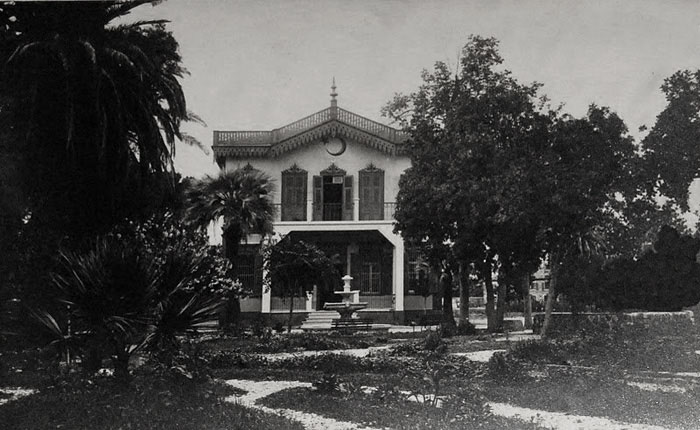 |
The Omeros house of Alaybey, Karşıyaka in its later conversion, used as an orphanage school of the Çocuk Esirgeme Kurumu in the early days of the Republic. The villas of this family have been replaced by a new building but the park with the trees is still attractive. It was a property of 90 acres (dönüm) behind the great walls there were two beautiful villas one with 15 rooms and the other with 8. There were stables, horses, carriages and all kind of trees. The owner Karolos F. Omiros (1837-1908) had brought from Italy specialist gardeners and he had 2000 trees and various flowers such as magnolia growing here. Karolos was married to Christina Baltazzi (1844-1899) daughter of my great great grand father Emanuele and she brought as per the marriage contract at the Austrian Consulate dated 26 April 1862 a dowry of 13.000 English pounds
Click here for more views of old Cordelio
Click here for an abridged family tree of the Omeros family, showing connections with some of the Levantine families of Smyrna, kindly submitted by Mr George Vassiadis, 2007.
Click here for Mr Baltazzi’s companion article on the heritage of Boudja.
Click here for Mr Baltazzi’s companion article on the heritage of Paradiso / Şirinyer.
Click here for Mr Baltazzi’s companion article on the heritage of Seydiköy.
Click here for Mr Baltazzi’s companion article on the heritage of Bournabat / Bornova.
Click here for Mr Baltazzi’s companion article on the heritage of Bayraklı / Turan and region.
